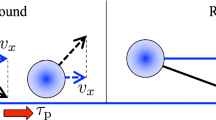Abstract
Profiles of temperature and humidity are calculated for a snow surface being cooled by outgoing radiation assuming no wind. These suggest that fog would necessarily form to block the cooling and, even in the absence of fog, the diffusion of water vapor to the surface could not account for observed rates of surface hoar growth. Therefore turbulent transfer to an interfacial sublayer with a very large temperature gradient must occur at least intermittently. In mountainous areas, gravity drainage of air over the interfacial sublayer probably accounts for the turbulence since air currents from a regional pressure gradient appear to transfer enough heat to the surface to prevent surface hoar growth. The vapor must diffuse through a 1 mm interfacial sublayer until the crystals reach a sufficient height to interact with the drainage wind.
Similar content being viewed by others
References
Andreas, E. L.: 1987, ‘A Theory for the Scalar Roughness and the Sealer Transfer Coefficients over Snow and Sea Ice’, Boundary-Layer Meteorol. 38 (112), 159–184.
Busch, N. E.: 1973, ‘On the Mechanics of Atmospheric Turbulence’, in Workshop on Micrometeorology, Amer. Meteor. Soc., 1–65.
Businger, J. A.: 1973, ‘Turbulent Transfer in the Atmospheric Surface Layer’, in Workshop on Micrometeorology Amer. Meteor. Soc., 67–100.
Businger, J. A. and Rao, K. R.: 1965, ‘The Formation of Drainage Wind on a Snow-Dome’, J. Glaciol. 5, 833–841.
Carslaw, H. S. and Jaeger, J. C.: 1959, Conduction of Heat in Solids (2nd edition), Oxford.
Deardorff, J. W.: 1968 ‘Dependence of air-sea transfer coefficients on bulk stability’, J. Geophys. Res. 73, 2549–2557.
Fleagle, R. G. and Businger, J. A.: 1980, An Introduction to Atmospheric Physics (2nd edition), Academic Press.
Geiger, R.: 1961, The Climate Near the Ground, Harvard.
Lang, R. M., Leo, B. R., and Brown, R. L.: 1984, ‘Observations on the Growth Processes and Strength Characteristics of Surface Hoar’, in Proceedings International Snow Science Workshop, Mountain Rescue-Aspen, Aspen, 188–195.
Monin, A. S. and Yaglom, A. M.: 1971, Statistical Fluid Mechanics: Mechanics of Turbulence (Vol. 1), MIT.
Nyberg, A.: 1939, ‘Temperature Measurements in an Air Layer Very Close to a Snow Surface’, Statens Meteorologik-Hydrografiska Anstalt, Meddelanden Serien Uppsatser 27, 234–275.
Richardson, L. F.: 1920, ‘The Supply of Energy from and to Atmospheric Eddies’, Proc. Roy. Soc. London A97, 354–373.
Seligman, G.: 1936, Snow Structure and Ski Fields, Macmillian.
Sutton, O. G.: 1953, Micrometeorology, McGraw-Hill.
Webb, E. K.: ‘Profile relationships: the log-linear range, and extension to strong stability’, Quart. J. R. Meteorol. Soc. 96, 67–90.
Yoshino, M. M.: 1975, Climate in a Small Area, University of Tokyo Press.
Author information
Authors and Affiliations
Rights and permissions
About this article
Cite this article
Colbeck, S.C. On the micrometeorology of surface hoar growth on snow in mountainous area. Boundary-Layer Meteorol 44, 1–12 (1988). https://doi.org/10.1007/BF00117290
Received:
Issue Date:
DOI: https://doi.org/10.1007/BF00117290




